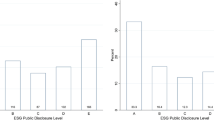Abstract
This study examines the pricing of personal loans in the form of second mortgages to determine whether state-specific default laws have an effect on the availability and cost of that debt. We examine the pricing of loans to higher risk borrowers and whether borrowers in states that limit lender ability to seek default remedies pay higher credit costs. Our results indicate that, for the most part, lenders rationally price loans to higher risk borrowers. However, when we focus on borrowers with low credit scores, the results indicate that mean actual loan rates are higher than those predicted by our model. The results also indicate that state-specific default laws have an effect on the price of credit. Finally, the results show that there is a greater degree of error in the pricing of second mortgage loans to borrowers with low credit scores than to borrowers with high credit scores.
Similar content being viewed by others
References
Alston, L. (1984). “Farm Foreclosure Moratorium Legislation: A Lesson from the Past,” American Economic Review 74, 445–457.
Ambrose, B. W., and Buttimer Jr., R. J. (2000). “Embedded Options in the Mortgage Contract,” The Journal of Real Estate Finance and Economics 21(2), 95–111.
Ambrose, B. W., Buttimer Jr., R. J., and Capone Jr., C. A. (1997). “Pricing Mortgage Default and Foreclosure Delay,” Journal of Money, Credit, and Banking 29(3), 314–325.
Ambrose, B. W., and Pennington-Cross, A. (2000). “Local Economic Risk Factors and the Primary and Secondary Mortgage Markets,” Regional Science and Urban Economics 30(6), 683–701.
Ambrose, B.W., M. LaCour-Little, and A. Sanders. (2003). “Credit Spreads and Capital Structure: Evidence from the Mortgage Market,” Ohio State University Working Paper.
Bakshi, Madan, and Zhang. (2000).
Barth, J. R., Cordes, J., and Yezer, A. (1983). “FHA Mortgage Insurance and High Risk Mortgage Lending: Some Lessons for Policy,” Housing Finance Review 2(2), 93–103.
Barth, J. R., Gotur, P., Manage, N., and Yezer, A. (1983). “The Effect of Government Regulations on Personal Loan Markets,” Journal of Finance 38(4), 1233–1251.
Barth, J. R., Cordes, J., and Yezer, A. (1986). “Benefits and Costs of Legal Restrictions on Personal Loan Markets,” Journal of Law and Economics 29, 357–380.
Berkowitz, J., and Hynes, R. (1999). “Bankruptcy Exemptions and the Market for Mortgage Loans,” Journal of Law and Economics 42, 809–830.
Bolton, P., and Scharfstein, D. (1996). “Optimal Debt Structure and the Number of Creditors,” Journal of Political Economy 104(1), 1–25.
Brueckner, J. K. (1994). “Unobservable Default Propensities, Optimal Leverage, and Empirical Default Models: Comments on ‘Bias in Estimates of Discrimination and Default in Mortgage Lending: The Effects of Simultaneity and Self-Selection’,” Journal of Real Estate Finance and Economics 9(3) 217–222.
Brueckner, J. K. (2000). “Mortgage Default with Asymmetric Information,” Journal of Real Estate Finance and Economics 20, 251–275.
Clauretie, T. M., and Herzog, T. (1990). “The Effect of State Foreclosure Laws on Loan Losses: Evidence from the Mortgage Insurance Industry,” Journal of Money, Credit and Banking 22(20), 221–233.
Collin-Dufresne, Goldstein, and Martin. (1999).
Diamond, D. (1991). “Debt Maturity Structure and Liquidity Risk,” Quarterly Journal of Economics 709–737.
Duffee. (1998).
Duffee. (1999).
Duffee and Singleton. (1999).
Ericsson and Renault. (2000).
Flannery, M. (1986). “Asymmetric Information and Risky Debt Maturity Choice,” Journal of Finance 41, 18–38.
Gonzalez-Rivera, G. (2001). “Linkages Between Secondary and Primary Markets for Mortgages,” Journal of Fixed Income 29–36.
Harrison, D.M., T.G. Noordewier, and A. Yavas. (2002). “Do Riskier Borrowers Borrow More?” Pennsylvania State University Working Paper.
Kau, J. B., and Keenan, D. C. (1995). “An Overview of the Option-Theoretic Pricing of Mortgages,” Journal of Housing Research 6(2), 217–244.
Kolari, J. W., Fraser, D. R., and Anari, A. (1998). “The Effects of Securitization on Mortgage market Yields: A Cointegration Analysis,” Real Estate Economics 26(4), 677–693.
Lin, E. Y., and White, M. J. (2001). “Bankruptcy and the Market for Mortgage and Home Improvement Loans,” Journal of Urban Economcis 50, 138–162.
Ling, D. C., and McGill, G. A. (1998). “Evidence on the Demand for Mortgage Debt by Owner-Occupants,” Journal of Urban Economics 44, 391–414.
Meador, M. (1982). “The Effect of Mortgage Laws on Home Mortgage Rates,” Journal of Economics and Business 34, 143–148.
Merton, R. C. (1974). “Theory of Rational Option Pricing,” Bell Journal of Economics 4, 141–183.
Pence, K.M. (2002). “Foreclosing on Opportunity: State Laws and Mortgage Credit,” Board of Governors of the Federal Reserve System Working Paper.
Quercia, R., and Stegman, M. A. (1992). “Residential Mortgage Default: A Review of the Literature,” Journal of Housing 3, 341–380.
Rothschild, M., and Stiglitz, J. (1976). “Equilibrium in Competitive Insurance Markets: An Essay on the Economics of Imperfect Information,” Quarterly Journal of Economics 90, 629–649.
Author information
Authors and Affiliations
Corresponding author
Rights and permissions
About this article
Cite this article
Ambrose, B.W., Sanders, A.B. Legal Restrictions in Personal Loan Markets. J Real Estate Finan Econ 30, 133–151 (2005). https://doi.org/10.1007/s11146-004-4876-y
Issue Date:
DOI: https://doi.org/10.1007/s11146-004-4876-y




